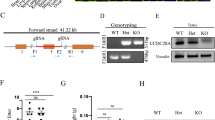Abstract
The study of the male and female karyotypes of the polychaete Dinophilus gyrociliatus was performed with the aim of ascertaining the diploid number of chromosomes and confirming the existence of karyological differences between the two sexes. Our results evidenced that the female karyotype of D. gyrociliatus consists of 2n=24 chromosomes, while the male karyotype has 2n=23 chromosomes. X chromosomes are subtelocentric and much bigger than the autosomes. The size of the D. gyrociliatus chromosomes, which in the female embryos vary in length from little more than 2.8 μm to less than 0.7 μm, are relatively small by comparison with those of other polychaetes. The existence of maternal and environmental factors able to influence the sex ratio of D. gyrociliatus and chromosomal differences between the sexes confirms that: (1) sex determination is chromosomal and syngamic of the XX–X0 type and (2) control of the sex ratio is progamic and depends on genetic and environmental factors.



Similar content being viewed by others
References
Bacci G (1956) Indicazioni di un effetto materno nella determinazione sessuale di Dinophilus gyrociliatus (=D. apatris). Ric Sci 26:71–76
De Beauchamp P (1910) Sur l'existence et les conditions de la parthénogènes chez Dinophilus. C R Acad Sci Ser III Sci Vie 150:739–741
Dixon DR, Pascoe PL, Dixon LRJ (1998) Karyotypic differences between two species of Potamoceros, P. triqueter and P. lamarckii (Polychaeta: Serpulidae). J Mar Biol Assoc UK 78:1113–1126
Gambi MC, Ramella L, Sella G, Protto P, Aldieri E (1997) Variation in genome size in benthic polychaetes: systematic and ecological relationships. J Mar Biol Assoc UK 77:1045–1057
Hartmann M (1943) Die Sexualität. Fischer, Jena
Jha AN, Hutchinson TH, Mackay JM, Elliot BM, Pascoe PL, Dixon DR (1995) The chromosomes of Platynereis dumerilii (Polychaeta: Nereidae). J Mar Biol Assoc UK 75:551–562
Korablev PV, Radashevsky VI, Mancenko GP (1999) The XX–X0 (male heterogametic) sex chromosome system in Polydora curiosa (Polychaeta: Spionidae). Ophelia 51:193–201
Levan A, Fredga K, Sandberg AA (1964) Nomenclature for centromeric position on chromosomes. Hereditas 52:201–220
Malsen H von (1906) Geschlechtsbestimmende Einflüsse und Eibildung des Dinophilus apatris. Arch Mikrosk Anat EntwMech 69:63
Martin F, Traut W (1987) The mode of sex determination in Dinophilus gyrociliatus (Archiannelida). Int J Invertebr Reprod Dev 11:159–172
Padoa E (1948) Storia naturale del sesso. Einaudi, Torino
Petraitis PS (1985) Digametic sex determination in the marine polychaete Capitella capitata (species type 1). Heredity 54:151–156
Petraitis PS (1991) The effects of sex ratio and density on the expression of gender in the polychaete Capitella capitata. Evol Ecol 5:393–404
Pfannenstiel HD (1984) Sex determination and intersexuality in polychaetes. In: Fisher A, Pfannenstiel HD (eds) Fortschritte der Zoologie, vol 29: Polychaete Reproduction. Fisher, Stuttgart, pp 81–98
Premoli MC, Sella G, Berra GP (1996) Heritable variation of sex ratio in a polychaete worm. J Evol Biol 9:845–854
Prevedelli D, Simonini R (2000) Effects of salinity and two food regimes on survival, fecundity and sex ratio in two groups of Dinophilus gyrociliatus (Polychaeta: Dinophilidae). Mar Biol 137:23–29
Prevedelli D, Simonini R (2001) Effects of diet and laboratory rearing on demography of Dinophilus gyrociliatus (Polychaeta: Dinophilidae). Mar Biol 139:929–935
Prevedelli D, Zunarelli Vandini R (1999) Survival, fecundity and sex ratio of Dinophilus gyrociliatus (Polychaeta: Dinophilidae) under different dietary conditions. Mar Biol 132:231–236
Prowazek S (1900) Zur Entwicklungsgeschichte des Wurmes Dinophilus apatris. Natwiss Wschr 15:397–399
Sato M, Ikeda M (1992) Chromosomal complements of two forms of Neanthes japonica (Polychaeta, Nereididae) with evidence of male-heterogametic sex chromosomes. Mar Biol 112:299–307
Sella G, Vitturi R, Ramella L, Colomba MS (1995) Chromosomal nucleolar organizer region (NOR) phenotypes in nine species of the genus Ophryotrocha (Polychaeta: Dorvilleidae). Mar Biol 124:425–433
Shearer C (1912) The problem of sex determination in Dinophilus gyrociliatus. I. The sexual cycle. Q J Microsc Sci 57:329–371
Sitnikova TY, Poberezhny ES (1996) Chromosomes of Baikalian polychaetes of the genus Manayunkia (Sedentaria, Sabellidae). In: Gokhman VE, Kuznetsova VG (eds) Karyosystematics of the invertebrate animals, vol 3. Moscow State University, Moscow, pp 67–69
Soldi R, Ramella L, Gambi MC, Sordino P, Sella G (1994) Genome size in Polychaetes: relationship with body length and life habit. Mem Mus Natl Hist Nat 162:129–135
Traut W (1966) Eine Mutante mit vergrösserten Männchen-Eiern bei Dinophilus gyrociliatus (Archiannelida). Experientia 22:237–238
Traut W (1969) Zur Sexualität von Dinophilus gyrociliatus (Archiannelida). I. Der Einfluß von Außenbedingungen und genetischen Faktoren auf das Geschlechtsverhältnis. Biol Zbl 88:469–495
Traut W (1970) Zur Sexualität von Dinophilus gyrociliatus (Archiannelida). III. Die Geschlechtsbestimmung. Biol Zbl 89:137–161
Tzonis K (1938) Beeinflussung der Geschlechtsverhältnisse bei Dinophilus apatris Korsch. durch Außenbedingungen. Zool Jb 58:433–574
Vitturi R, Ramella L, Colomba MS, Caputo V, Sella G (2000) NOR regions of polychaete worms of the genus Ophryotrocha studied by chromosomes banding techniques and FISH. J Hered 91:18–23
Westheide W (1984) The concept of reproduction in polychaetes with small body size: adaptation in interstitial species. In: Fisher A, Pfannenstiel HD (eds) Fortschritte der Zoologie, vol 29: Polychaete Reproduction. Fisher, Stuttgart, pp 265–287
Zunarelli Vandini R (1965) A possible way of origin of parthenogenetic strains of Dinophilus apatris (=Dinophilus gyrociliatus). Experientia 21:388
Acknowledgements
The authors wish to thank G. Sella (Turin) and M. Mandrioli, T. Altiero, L. Rebecchi (Modena) for criticism and suggestions that greatly improved the manuscript. This work was supported by the Italian Ministero dell'Università e della Ricerca (MIUR).
Author information
Authors and Affiliations
Corresponding author
Additional information
Communicated by R. Cattaneo-Vietti, Genova
Rights and permissions
About this article
Cite this article
Simonini, R., Molinari, F., Pagliai, A.M. et al. Karyotype and sex determination in Dinophilus gyrociliatus (Polychaeta: Dinophilidae). Marine Biology 142, 441–445 (2003). https://doi.org/10.1007/s00227-002-0979-2
Received:
Accepted:
Published:
Issue Date:
DOI: https://doi.org/10.1007/s00227-002-0979-2




